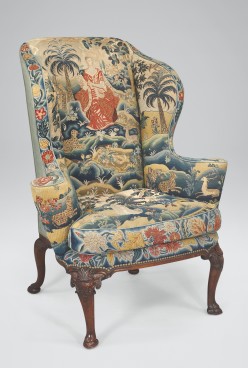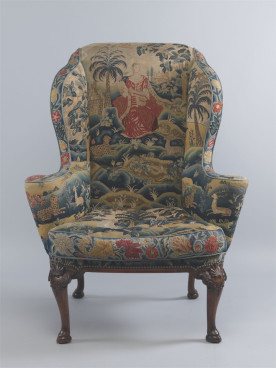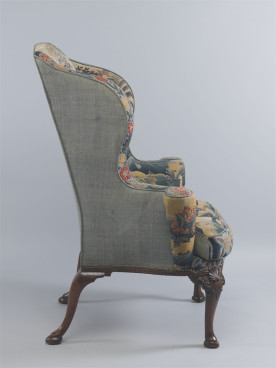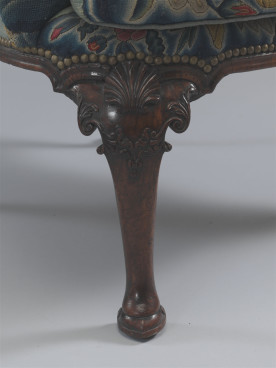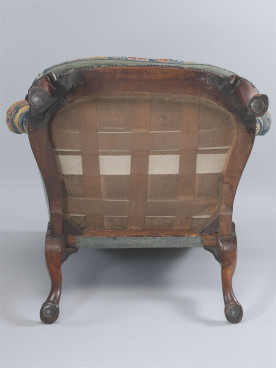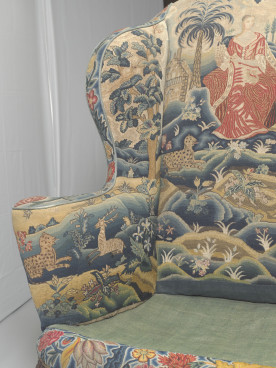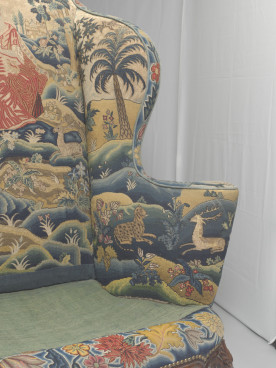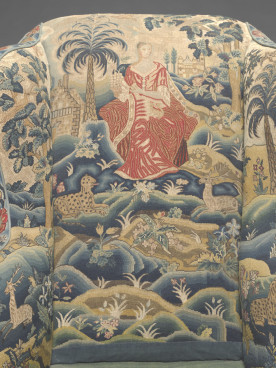Easy chair, c.1730–40
Walnut, now with 18th-century needlework
This chair was formerly in the collections of Percival D. Griffiths (1862–1937) and Colonial Williamsburg, Virginia.
Adam Bowett Catalogue (19/08/2012)
Description
An easy chair, c.1730-40. The interior faces of the back, cheeks and sides, as well as the front edge of the seat and the loose cushion, are covered with petit point needlework of figures, animals and plants in a mythical landscape. The back and sides of the chair are closed by a plain blue cloth. The chair has a square back with slightly raised top, curved cheeks and scrolled sides over a flared seat with conforming loose cushion, raised on shell-carved cabriole forelegs with additional delicate foliate carving and a stylised hoof foot, plain cabriole back legs. The base of the seat frame has a small applied cross-grain moulding.
Dimensions
H: 48 ¾ ” (124cm) Seat height: (without squab) 16 ½” (42cm) W: 38”, 97cm D: 31 ½ “ (80cm)
Materials
Walnut, beech, softwood, various upholstery materials.
Dating criteria
Baroque treatment of the lower frame is unlikely to be much later than 1740.
Construction
The construction of the frame is for the most part conjectural because it is enclosed in textile. The broad seat rails are entirely of walnut, half-lapped at the front corners with the legs being either tenoned or dovetailed through the joint. At the back the rails are tenoned into the back legs. The back legs are thicknessed on the outer face of the knee and toe to enhance the curve and have small walnut bracket applied on each side of the knee. There are softwood reinforcing blocks nailed into the back corners. The front legs have shaped walnut brackets supporting the knee with softwood reinforcing blocks behind. The cross-grain moulding is applied in short sections to the lower edge of the frame.
Marks or stamps
There is an inventory number on the inside left rear leg in red pencil ’56-30’ (possibly a Colonial Williamsburg or Percival Griffiths number).
Condition
For condition of the upholstered frame refer to Hampton court report of April 1993 by Kate Gill.
All seat rails are original, with historic worm damage especially to the back rail. The right side rail has a large repair in beech where it joins to the rear leg and there is a corresponding walnut insert to the top of the leg indicating catastrophic failure at this point. The nailed blocks for both rear corners are not original. Both front legs are original, although reinforcement blocks and knee brackets have clearly been repaired at some time. There are domed gliders to all four feet and evidence of a castor (?) fitted to the right front. The back rail, which has been badly wormed, has been divided longitudinally and reinforced with a beech wood batten about 5/8” thick.
Additional remarks
A fine quality chair with good needlework
References
Fastnedge, The Connoisseur’s Period Guide, pl. 22A.
R. W. Symonds, ‘A Century of Furniture Collecting’, Connoisseur, Antique Dealers Fair and Exhibition, June 1954, p. 16.
Provenance
By repute Percival D. Griffiths collection.
Collection of Geoffrey Heart.
Purchased by R. Symonds for Colonial Williamsburg & exhibited Governors bedchamber, Governors Palace, Colonial Williamsburg 1956-81.
Sotheby’s New York 24th October 1992
Sotheby’s 28th October 1992
Hotspur 28th October 19992
Purchased

